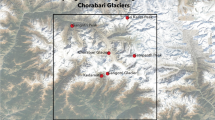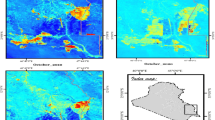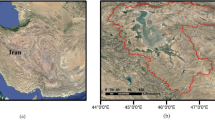Abstract
The Hindu Kush Himalaya (HKH) is one of the major sources of fresh water on Earth and is currently under serious threat of climate change. This study investigates the future water availability in the Langtang basin, Central Himalayas, Nepal under climate change scenarios using state-of-the-art machine learning (ML) techniques. The daily snow area for the region was derived from MODIS images. The outputs of climate models were used to project the temperature and precipitation until 2100. Three ML models, including Gated recurrent unit (GRU), Long short-term memory (LSTM), and Recurrent neural network (RNN), were developed for snowmelt runoff prediction, and their performance was compared based on statistical indicators. The result suggests that the mean temperature of the basin could rise by 4.98 °C by the end of the century. The annual average precipitation in the basin is likely to increase in the future, especially due to high monsoon rainfall, but winter precipitation could decline. The annual river discharge is projected to upsurge significantly due to increased precipitation and snowmelt, and no shift in hydrograph is expected in the future. Among three ML models, the LSTM model performed better than GRU and RNN models. In summary, this study depicts severe future climate change in the region and quantifies its effect on river discharge. Furthermore, the study demonstrates the suitability of the LSTM model in streamflow prediction in the data-scarce HKH region. The outcomes of this study will be useful for water resource managers and planners in developing strategies to harness the positive impacts and offset the negative effects of climate change in the basin.










Similar content being viewed by others
Data availability
The datasets generated during the current study are available from the corresponding author on reasonable request.
References
Ahluwalia, R. S., Rai, S. P., Gupta, A. K., Dobhal, D. P., Tiwari, R. K., Garg, P. K., & Kesharwani, K. (2016). Towards the understanding of the flash flood through isotope approach in Kedarnath valley in June 2013, Central Himalaya. India. Natural Hazards, 82(1), 321–332. https://doi.org/10.1007/s11069-016-2203-6
ASCE. (2000). Artificial neural networks in hydrology. II: Hydrologic applications. Journal of Hydrologic Engineering, 5(2), 124–137. https://doi.org/10.1061/(ASCE)1084-0699(2000)5:2(124)
Ateeq-ur-Rauf, Ghumman, A. R., Ahmad, S., & Hashmi, H. N. (2018). Performance assessment of artificial neural networks and support vector regression models for stream flow predictions. Environmental Monitoring and Assessment, 190(12). https://doi.org/10.1007/s10661-018-7012-9
Bajracharya, A. R., Bajracharya, S. R., Shrestha, A. B., & Maharjan, S. B. (2018). Climate change impact assessment on the hydrological regime of the Kaligandaki Basin. Nepal. Science of the Total Environment, 625, 837–848. https://doi.org/10.1016/j.scitotenv.2017.12.332
Bhatta, B., Shrestha, S., Shrestha, P. K., & Talchabhadel, R. (2019). Evaluation and application of a SWAT model to assess the climate change impact on the hydrology of the Himalayan River Basin. CATENA, 181, 104082. https://doi.org/10.1016/j.catena.2019.104082
Cho, K., van Merrienboer, B., Gulcehre, C., Bahdanau, D., Bougares, F., Schwenk, H., & Bengio, Y. (2014). Learning phrase representations using RNN encoder-decoder for statistical machine translation. EMNLP 2014 - 2014 Conference on Empirical Methods in Natural Language Processing, Proceedings of the Conference, 1724–1734. https://doi.org/10.3115/v1/d14-1179
Dimri, A. P., Thayyen, R. J., Kibler, K., Stanton, A., Jain, S. K., Tullos, D., & Singh, V. P. (2016). A review of atmospheric and land surface processes with emphasis on flood generation in the Southern Himalayan rivers. Science of the Total Environment, 556, 98–115. https://doi.org/10.1016/j.scitotenv.2016.02.206
Durrant, P. J. (2001). winGammaTM: A non-linear data analysis and modelling tool with applications to flood prediction. Cardiff University.
Fenu, G., & Malloci, F. M. (2020). DSS LANDS: a decision support system for agriculture in Sardinia. HighTech and Innovation Journal, 1(3), 129–135. https://doi.org/10.28991/hij-2020-01-03-05
Farfán, J. F., Palacios, K., Ulloa, J., & Avilés, A. (2020). A hybrid neural network-based technique to improve the flow forecasting of physical and data-driven models: methodology and case studies in Andean watersheds. Journal of Hydrology: Regional Studies, 27(November 2018), 100652. https://doi.org/10.1016/j.ejrh.2019.100652
Hall, D. K., & Riggs, G. A. (2007). Accuracy assessment of the MODIS snow products. Hydrological Processes, 21(12), 1534–1547. https://doi.org/10.1002/hyp.6715
Hall, D.K., & Riggs, G.A. (2016). MODIS/Terra Snow Cover 8-Day L3 Global 500m SIN Grid, version 6. Boulder, Colorado USA. NASA NSIDC DAAC. https://doi.org/10.5067/MODIS/MOD10A2.006. Accessed on August 29, 2018.
Hochreiter, S., & Schmidhuber, J. (1997). Long short-term memory. Neural Computation, 9(8), 1735–1780. https://doi.org/10.1162/neco.1997.9.8.1735
ICIMOD. (2016). High resolution 10 km daily future climate dataset of Indus, Ganges, and Bramhmaputra river basins from 2011 to 2100. Kathmandu, Nepal: ICIMOD.
Immerzeel, W. W., van Beek, L. P. H., Konz, M., Shrestha, A. B., & Bierkens, M. F. P. (2012). Hydrological response to climate change in a glacierized catchment in the Himalayas. Climatic Change, 110, 721–736. https://doi.org/10.1007/s10584-011-0143-4
Immerzeel, W. W., Pellicciotti, F., & Bierkens, M. F. P. (2013). Rising river flows throughout the twenty-first century in two Himalayan glacierized watersheds. Nature Geoscience, 6(9), 742–745. https://doi.org/10.1038/ngeo1896
IPCC. (2014). Climate Change 2014 - The Physical Science Basis. Cambridge University Press, Cambridge. https://doi.org/10.1017/CBO9781107415324
Jain, S. K., Goswami, A., & Saraf, A. K. (2010). Assessment of snowmelt runoff using remote sensing and effect of climate change on runoff. Water Resources Management, 24(9), 1763–1777. https://doi.org/10.1007/s11269-009-9523-1
Kratzert, F., Klotz, D., Brenner, C., Schulz, K., & Herrnegger, M. (2018). Rainfall-runoff modelling using Long Short-Term Memory (LSTM) networks. Hydrology and Earth System Sciences, 22(11), 6005–6022. https://doi.org/10.5194/hess-22-6005-2018
Lutz, A. F., Immerzeel, W. W., Shrestha, A. B., & Bierkens, M. F. P. (2014). Consistent increase in High Asia’s runoff due to increasing glacier melt and precipitation. Nature Climate Change, 4(7), 587–592. https://doi.org/10.1038/nclimate2237
Lutz, A. F., ter Maat, H. W., Biemans, H., Shrestha, A. B., Wester, P., & Immerzeel, W. W. (2016). Selecting representative climate models for climate change impact studies: An advanced envelope-based selection approach. International Journal of Climatology, 36(12), 3988–4005. https://doi.org/10.1002/joc.4608
Nagesh Kumar, D., Srinivasa Raju, K., & Sathish, T. (2004). River flow forecasting using recurrent neural networks. Water Resources Management, 18(2), 143–161. https://doi.org/10.1023/B:WARM.0000024727.94701.12
Nash, J. E., & Sutcliffe, J. V. (1970). River flow forecasting through conceptual models part I—a discussion of principles. Journal of Hydrology, 10, 282–290. https://doi.org/10.1016/0022-1694(70)90255-6
Oo, H. T., Zin, W. W., & Thin Kyi, C. C. (2019). Assessment of future climate change projections using multiple global climate models. Civil Engineering Journal, 5(10), 2152–2166. https://doi.org/10.28991/cej-2019-03091401
Pandey, V. P., Dhaubanjar, S., Bharati, L., & Thapa, B. R. (2020). Spatio-temporal distribution of water availability in Karnali-Mohana Basin, Western Nepal: Climate change impact assessment (Part-B). Journal of Hydrology: Regional Studies, 29, 100691. https://doi.org/10.1016/j.ejrh.2020.100691
Pradhan, P., Tingsanchali, T., & Shrestha, S. (2020). Evaluation of Soil and Water Assessment Tool and Artificial Neural Network models for hydrologic simulation in different climatic regions of Asia. Science of the Total Environment, 701, 134308. https://doi.org/10.1016/j.scitotenv.2019.134308
Pradhananga, N. S., Kayastha, R. B., Bhattarai, B. C., Adhikari, T. R., Pradhan, S. C., Devkota, L. P., Shrestha, A. B., & Mool, P. K. (2014). Estimation of discharge from Langtang River basin, Rasuwa, Nepal, using a glacio-hydrological model. Annals of Glaciology, 55, 223–230. https://doi.org/10.3189/2014AoG66A123
Ragettli, S., Pellicciotti, F., Immerzeel, W. W., Miles, E. S., Petersen, L., Heynen, M., Shea, J. M., Stumm, D., Joshi, S., & Shrestha, A. (2015). Unraveling the hydrology of a Himalayan catchment through integration of high resolution in situ data and remote sensing with an advanced simulation model. Advances in Water Resources, 78, 94–111. https://doi.org/10.1016/j.advwatres.2015.01.013
RGI Consortium. (2017). Randolph Glacier Inventory – A Dataset of Global Glacier Outlines: Version 6.0: Technical Report, Global Land Ice Measurements from Space, Colorado, USA. Digital Media. https://doi.org/10.7265/N5-RGI-60
Shea, J. M., Immerzeel, W. W., Wagnon, P., Vincent, C., & Bajracharya, S. (2015). Modelling glacier change in the Everest region. Nepal Himalaya. the Cryosphere, 9(3), 1105–1128. https://doi.org/10.5194/tc-9-1105-2015
Shrestha, S., Shrestha, M., & Babel, M. S. (2017). Assessment of climate change impact on water diversion strategies of Melamchi Water Supply Project in Nepal. Theoretical and Applied Climatology, 128(1–2), 311–323. https://doi.org/10.1007/s00704-015-1713-6
Singh, L., & Saravanan, S. (2020). Impact of climate change on hydrology components using CORDEX South Asia climate model in Wunna, Bharathpuzha, and Mahanadi. India. Environmental Monitoring and Assessment, 192(11), 678. https://doi.org/10.1007/s10661-020-08637-z
Singh, S. P., Bassignana-Khadka, I., Karky, B. S., Sharma, E., Eklabya, S., & Sharma, E. (2011). Climate change in the Hindu Kush-Himalayas: The state of current knowledge. ICIMOD.
Stefánsson, A., Končar, N., & Jones, A. J. (1997). A note on the gamma test. Neural Computing and Applications, 5(3), 131–133. https://doi.org/10.1007/BF01413858
Stigter, E. M., Wanders, N., Saloranta, T. M., Shea, J. M., Bierkens, M. F. P., & Immerzeel, W. W. (2017). Assimilation of snow cover and snow depth into a snow model to estimate snow water equivalent and snowmelt runoff in a Himalayan catchment. The Cryosphere, 11(4), 1647–1664. https://doi.org/10.5194/tc-11-1647-2017
Tankpa, V., Wang, L., Awotwi, A., Singh, L., Thapa, S., Atanga, R. A., & Guo, X. (2020). Modeling the effects of historical and future land use/land cover change dynamics on the hydrological response of Ashi watershed, northeastern China. Environment, Development and Sustainability. https://doi.org/10.1007/s10668-020-00952-2
Thanh, N. T. (2019). Evaluation of multi-precipitation products for multi-time scales and spatial distribution during 2007–2015. Civil Engineering Journal, 5(1), 255. https://doi.org/10.28991/cej-2019-03091242
Thapa, S., Li, B., Fu, D., Shi, X., Tang, B., Qi, H., & Wang, K. (2020a). Trend analysis of climatic variables and their relation to snow cover and water availability in the Central Himalayas: A case study of Langtang Basin. Nepal. Theor. Appl. Climatol., 140, 891–903. https://doi.org/10.1007/s00704-020-03096-5
Thapa, S., Zhao, Z., Li, B., Lu, L., Fu, D., Shi, X., Tang, B., & Qi, H. (2020b). Snowmelt-driven streamflow prediction using machine learning techniques (LSTM, NARX, GPR, and SVR). Water, 12(6), 1734. https://doi.org/10.3390/w12061734
Uysal, G., Şensoy, A., & Şorman, A. A. (2016). Improving daily streamflow forecasts in mountainous Upper Euphrates basin by multi-layer perceptron model with satellite snow products. Journal of Hydrology, 543, 630–650. https://doi.org/10.1016/j.jhydrol.2016.10.037
van Vuuren, D. P., Edmonds, J., Kainuma, M., Riahi, K., Thomson, A., Hibbard, K., et al. (2011). The representative concentration pathways: An overview. Climatic Change, 109(1), 5–31. https://doi.org/10.1007/s10584-011-0148-z
Wester, P., Mishra, A., Mukherji, A., & Shrestha, A.B. (Eds.). (2019). The Hindu Kush Himalaya Assessment, The Hindu Kush Himalaya Assessment. Springer International Publishing, Cham. https://doi.org/10.1007/978-3-319-92288-1
Yang, M., Zhong, P., Li, J., Liu, W., Li, Y., Yan, K., et al. (2020). Research on intelligent prediction and zonation of basin-scale flood risk based on LSTM method. Environmental Monitoring and Assessment, 192(6), 387. https://doi.org/10.1007/s10661-020-08351-w
Yazdani, M., & Rassafi, A. A. (2019). Evaluation of drivers’ affectability and satisfaction with black spots warning application. Civil Engineering Journal, 5(3), 576. https://doi.org/10.28991/cej-2019-03091269
Zeydalinejad, N., Nassery, H. R., Shakiba, A., & Alijani, F. (2020). Prediction of the karstic spring flow rates under climate change by climatic variables based on the artificial neural network: a case study of Iran. Environmental Monitoring and Assessment, 192(6). https://doi.org/10.1007/s10661-020-08332-z
Zhang, D., Lindholm, G., & Ratnaweera, H. (2018). Use long short-term memory to enhance Internet of Things for combined sewer overflow monitoring. Journal of Hydrology, 556, 409–418. https://doi.org/10.1016/j.jhydrol.2017.11.018
Acknowledgements
We express our thanks to the Department of hydrology and meteorology, Nepal for providing local hydrometeorological data and the Regional database system, ICIMOD for providing climate data for this work. This work was supported by the National Natural Science Foundation of China (grant number 51979066) and the State Key Laboratory of Urban Water Resource and Environment, Harbin Institute of Technology (grant number 2018TS01).
Author information
Authors and Affiliations
Corresponding authors
Ethics declarations
Conflict of interest
The authors declare no competing interests.
Additional information
Publisher's Note
Springer Nature remains neutral with regard to jurisdictional claims in published maps and institutional affiliations.
Highlights
• GRU, LSTM, and RNN models were developed for snowmelt runoff prediction.
• The increase in temperature and precipitation is projected in the future in the Langtang basin.
• Water availability in the basin is likely to increase until the end of this century.
Rights and permissions
About this article
Cite this article
Thapa, S., Li, H., Li, B. et al. Impact of climate change on snowmelt runoff in a Himalayan basin, Nepal. Environ Monit Assess 193, 393 (2021). https://doi.org/10.1007/s10661-021-09197-6
Received:
Accepted:
Published:
DOI: https://doi.org/10.1007/s10661-021-09197-6




